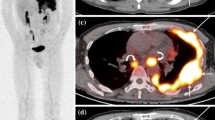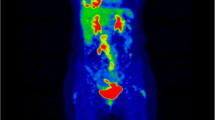Abstract
Purpose
This study investigated the diagnostic performance and prognostic value of fluorodeoxyglucose (FDG) positron emission tomography (PET)/CT in suspected malignant pleural mesothelioma (MPM) recurrence, in the context of patterns and intensity of FDG uptake, histologic type, and treatment algorithm.
Methods
Fifty patients with MPM underwent FDG PET/CT for restaging 11 ± 6 months after therapy. Tumor relapse was confirmed by histopathology, and by clinical evolution and subsequent imaging. Progression-free survival was defined as the time between treatment and the earliest clinical evidence of recurrence. Survival after FDG PET/CT was defined as the time between the scan and death or last follow-up. Overall survival was defined as the time between initial treatment and death or last follow-up date.
Results
Treatment failure was confirmed in 42 patients (30 epithelial and 12 non-epithelial MPM). Sensitivity, specificity, accuracy, negative predictive value, and positive predictive value for FDG PET/CT were 97.6, 75, 94, 86, and 95.3%, respectively. FDG PET/CT evidence of single site of recurrence was observed in the ipsilateral hemithorax in 18 patients (44%), contralaterally in 2 (5%), and in the abdomen in 1 patient (2%). Bilateral thoracic relapse was detected in three patients (7%). Simultaneous recurrence in the ipsilateral hemithorax and abdomen was observed in ten (24%) patients and in seven (17%) in all three cavities. Unsuspected distant metastases were detected in 11 patients (26%). Four patterns of uptake were observed in recurrent disease: focal, linear, mixed (focal/linear), and encasing, with a significant difference between the intensity of uptake in malignant lesions compared to benign post-therapeutic changes. Lesion uptake was lower in patients previously treated with more aggressive therapy and higher in intrathoracic lesions of patients with distant metastases. FDG PET/CT helped in the selection of 12 patients (29%) who benefited from additional previously unplanned treatment at the time of failure. Multivariate analysis showed that histologic type remained the only independent predictor of progression-free survival. Survival after relapse was independently predicted by the pattern of FDG uptake and PET nodal status, and overall survival by the maximum standard uptake value.
Conclusion
FDG PET/CT is an accurate modality to diagnose and to estimate the extent of locoregional and distant MPM recurrence, and it carries independent prognostic value. Once the disease recurs, survival outcomes seem to be independent of histologic type and highly dependent on the intensity of lesion uptake and on the pattern of metabolically active disease in FDG PET/CT. Our observations should be considered limited to patients treated surgically with or without perioperative therapies and should not be extrapolated to those unresectable cases treated with chemotherapy alone.




Similar content being viewed by others
References
Rusch VW, Piantadosi S, Holmes EC. The role of extrapleural pneumonectomy in malignant pleural mesothelioma: a Lung Cancer Study Group trial. J Thorac Cardiovasc Surg 1991;102:1–9.
Pass HI, Kranda K, Temeck BK, Feuerstein I, Steinberg SM. Surgically debulked malignant pleural mesothelioma: results and prognostic factors. Ann Surg Oncol 1997;4:215–22.
Hilaris BS, Nori D, Kwong E, Kutcher GJ, Martini N. Pleurectomy and intraoperative brachytherapy and postoperative radiation in the treatment of malignant pleural mesothelioma. Int J Radiat Oncol Biol Phys 1984;10:325–31.
Rusch VW, Rosenzweig K, Venkatraman E, Leon L, Raben A, Harrison L, et al. A phase II trial of surgical resection and adjuvant high-dose hemithoracic radiation for malignant pleural mesothelioma. J Thorac Cardiovasc Surg 2001;122:788–95.
Holsti LR, Pyrhönen S, Kajanti M, Mäntylä M, Mattson K, Maasilta P, et al. Altered fractionation of hemithorax irradiation for pleural mesothelioma and failure patterns after treatment. Acta Oncol 1997;36:397–405.
Pass HI, Temeck BK, Kranda K, Thomas G, Russo A, Smith P, et al. Phase III randomized trial of surgery with or without intraoperative photodynamic therapy and postoperative immunochemotherapy for malignant pleural mesothelioma. Ann Surg Oncol 1997;4:628–33.
Rusch V, Saltz L, Venkatraman E, Ginsberg R, McCormack P, Burt M, et al. A phase II trial of pleurectomy/decortication followed by intrapleural and systemic chemotherapy for malignant pleural mesothelioma. J Clin Oncol 1994;12:1156–63.
Rice TW, Adelstein DJ, Kirby TJ, Saltarelli MG, Murthy SR, Van Kirk MA, et al. Aggressive multimodality therapy for malignant pleural mesothelioma. Ann Thorac Surg 1994;58:24–9.
Baldini EH, Recht A, Strauss GM, DeCamp MM, Swanson SJ, Liptay MJ, et al. Patterns of failure after trimodality therapy for malignant pleural mesothelioma. Ann Thorac Surg 1997;63(2):334–8.
Jänne PA, Baldini EH. Patterns of failure following surgical resection for malignant pleural mesothelioma. Thorac Surg Clin 2004;14(4):567–73.
Gill RR, Gerbaudo VH, Sugarbaker DJ, Hatabu H. Current trends in radiologic management of malignant pleural mesothelioma. Semin Thorac Cardiovasc Surg 2009;21(2):111–20.
Yamamuro M, Gerbaudo VH, Gill RR, Jacobson FL, Sugarbaker DJ, Hatabu H. Morphologic and functional imaging of malignant pleural mesothelioma. Eur J Radiol 2007;64(3):356–66.
Bénard F, Sterman D, Smith RJ, Kaiser LR, Albelda SM, Alavi A. Metabolic imaging of malignant pleural mesothelioma with fluorodeoxyglucose positron emission tomography. Chest 1998;114:713–22.
Schneider DB, Clary-Macy C, Challa S, Sasse KC, Merrick SH, Hawkins R, et al. Positron emission tomography with f18-fluorodeoxyglucose in the staging and preoperative evaluation of malignant pleural mesothelioma. J Thorac Cardiovasc Surg 2000;120:128–33.
Carretta A, Landoni C, Melloni G, Ceresoli GL, Compierchio A, Fazio F, et al. 18-FDG positron emission tomography in the evaluation of malignant pleural diseases – a pilot study. Eur J Cardiothorac Surg 2000;17:377–83.
Gerbaudo VH, Sugarbaker DJ, Britz-Cunningham S, Di Carli MF, Mauceri C, Treves ST. Assessment of malignant pleural mesothelioma with (18)F-FDG dual-head gamma-camera coincidence imaging: comparison with histopathology. J Nucl Med 2002;43:1144–9.
Gerbaudo VH. 18F-FDG imaging of malignant pleural mesothelioma: scientiam impendere vero. Nucl Med Commun 2003;24(6):609–14.
Erasmus JJ, Truong MT, Smythe WR, Munden RF, Marom EM, Rice DC, et al. Integrated computed tomography-positron emission tomography in patients with potentially resectable malignant pleural mesothelioma: staging implications. J Thorac Cardiovasc Surg 2005;129(6):1364–70.
Fiore D, Baggio V, Sotti G, Muzzio PC. Imaging before and after multimodal treatment for malignant pleural mesothelioma. Radiol Med 2006;111(3):355–64.
Tan C, Barrington S, Rankin S, Landau D, Pilling J, Spicer J, et al. Role of integrated 18-fluorodeoxyglucose position emission tomography-computed tomography in patients surveillance after multimodality therapy of malignant pleural mesothelioma. J Thorac Oncol 2010;5(3):385–8.
Ikezoe J, Kadowaki K, Morimoto S, Takashima S, Kozuka T, Nakahara K, et al. Mediastinal lymph node metastases from nonsmall cell bronchogenic carcinoma: reevaluation with CT. J Comput Assist Tomogr 1990;14(3):340–4.
Gerbaudo VH, Britz-Cunningham S, Sugarbaker DJ, Treves ST. Metabolic significance of the pattern, intensity and kinetics of 18F-FDG uptake in malignant pleural mesothelioma. Thorax 2003;58(12):1077–82.
Jones HA, Clark RJ, Rhodes CG, Schofield JB, Krausz T, Haslett C. Positron emission tomography of 18FDG uptake in localized pulmonary inflammation. Acta Radiol Suppl 1991;376:148.
Strauss LG. Fluorine-18 deoxyglucose and false-positive results: a major problem in the diagnostics of oncological patients. Eur J Nucl Med 1996;23:1409–15.
Zhuang H, Pourdehnad M, Yamamoto AJ, Rossman MD, Alavi A. Intense F-18 fluorodeoxyglucose uptake caused by mycobacterium avium intracellulare infection. Clin Nucl Med 2001;26(5):458.
Alavi A, Gupta N, Alberini JL, Hickeson M, Adam LE, Bhargava P, et al. Positron emission tomography imaging in nonmalignant thoracic disorders. Semin Nucl Med 2002;32(4):293–321.
Zhuang H, Duarte PS, Rebenstock A, Feng Q, Alavi A. Pulmonary clostridium perfringens infection detected by FDG positron emission tomography. Clin Nucl Med 2003;28(6):517–8.
Inoue T, Kim EE, Komaki R, Wong FC, Bassa P, Wong WH, et al. Detecting recurrent or residual lung cancer with FDG-PET. J Nucl Med 1995;36(5):788–93.
Nestle U, Hellwig D, Fleckenstein J, Walter K, Ukena D, Rübe C, et al. Comparison of early pulmonary changes in 18FDG-PET and CT after combined radiochemotherapy for advanced non-small-cell lung cancer: a study in 15 patients. Front Radiat Ther Oncol 2002;37:26–33.
Sonobe M, Nawkagawa M, Ichinose M, Ikegami N, Nagasawa M, Shindo T. Analysis of risk factors in bronchopleural fistula after pulmonary resection for primary lung cancer. Eur J Cardiothorac Surg 2000;18:519–23.
Jones HA, Clark RJ, Rhodes CG, Schofield JB, Krausz T, Haslett C. In vivo measurement of neutrophil activity in experimental lung inflammation. Am J Respir Crit Care Med 1994;149(6):1635–9.
Jones HA, Cadwallader KA, White JF, Uddin M, Peters AM, Chilvers ER. Dissociation between respiratory burst activity and deoxyglucose uptake in human neutrophil granulocytes: implications for interpretation of (18)F-FDG PET images. J Nucl Med 2002;43(5):652–7.
Zellos L, Christiani DC. Epidemiology, biologic behavior, and natural history of mesothelioma. Thorac Surg Clin 2004;14(4):469–77.
Lee ST, Ghanem M, Herbertson RA, Berlangieri SU, Byrne AJ, Tabone K, et al. Prognostic value of (18)F-FDG PET/CT in patients with malignant pleural mesothelioma. Mol Imaging Biol 2009;11(6):473–9.
Panageas KS, Ben-Porat L, Dickler MN, Chapman PB, Schrag D. When you look matters: the effect of assessment schedule on progression-free survival. J Natl Cancer Inst 2007;99(6):428–32.
Richards WG, Zellos L, Bueno R, Jaklitsch MT, Jänne PA, Chirieac LR, et al. Phase I to II study of pleurectomy/decortication and intraoperative intracavitary hyperthermic cisplatin lavage for mesothelioma. J Clin Oncol 2006;24(10):1561–7.
Ceresoli GL, Chiti A, Zucali PA, Cappuzzo F, De Vincenzo F, Cavina R, et al. Assessment of tumor response in malignant pleural mesothelioma. Cancer Treat Rev 2007;33(6):533–41.
Flores RM, Akhurst T, Gonen M, Zakowski M, Dycoco J, Larson SM, et al. Positron emission tomography predicts survival in malignant pleural mesothelioma. J Thorac Cardiovasc Surg 2006;132(4):763–8.
Nowak AK, Francis RJ, Phillips MJ, Millward MJ, van der Schaaf AA, Boucek J, et al. A novel prognostic model for malignant mesothelioma incorporating quantitative FDG-PET imaging with clinical parameters. Clin Cancer Res 2010;16(8):2409–17.
Jassem J, Ramlau R, Santoro A, Schuette W, Chemaissani A, Hong S, et al. Phase III trial of pemetrexed plus best supportive care compared with best supportive care in previously treated patients with advanced malignant pleural mesothelioma. J Clin Oncol 2008;26(10):1698–704.
Vogelzang NJ, Rusthoven JJ, Symanowski J, Denham C, Kaukel E, Ruffie P, et al. Phase III study of pemetrexed in combination with cisplatin versus cisplatin alone in patients with malignant pleural mesothelioma. J Clin Oncol 2003;21(14):2636–44.
van Meerbeeck JP, Gaafar R, Manegold C, Van Klaveren RJ, Van Marck EA, Vincent M, et al. Randomized phase III study of cisplatin with or without raltitrexed in patients with malignant pleural mesothelioma: an intergroup study of the European Organisation for Research and Treatment of Cancer Lung Cancer Group and the National Cancer Institute of Canada. J Clin Oncol 2005;23(28):6881–9.
Acknowledgement
Supported by a grant from the International Mesothelioma Program, Brigham & Women’s Hospital, Boston, MA.
Conflicts of interest
None.
Author information
Authors and Affiliations
Corresponding author
Rights and permissions
About this article
Cite this article
Gerbaudo, V.H., Mamede, M., Trotman-Dickenson, B. et al. FDG PET/CT patterns of treatment failure of malignant pleural mesothelioma: relationship to histologic type, treatment algorithm, and survival. Eur J Nucl Med Mol Imaging 38, 810–821 (2011). https://doi.org/10.1007/s00259-010-1704-x
Received:
Accepted:
Published:
Issue Date:
DOI: https://doi.org/10.1007/s00259-010-1704-x




